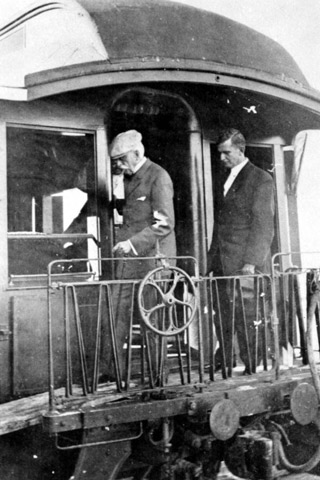Florida Keys Flagler Railroad Piece of Track
09-16-2019

It was Jan. 22, 1912 when the first train arrived in Key West, Florida. On board was Henry Flagler, the mastermind of the Florida East Coast Railroad system himself. The trip marked the end of a construction achievement and the beginning of an everlasting legacy for Flagler, who was the visionary of it all.
Flagler's vision to create a railway system that reached as far south as Key West began in the 1880s when he took a trip to St. Augustine for a honeymoon with his second wife, Ida Alice Shrouds. According to Jeff Donnelly, a former University of Miami English professor, it was during this visit when he noticed Florida's potential.
"He looked around and thought it was a great place. He realized he would be able to bring more people if there were better transportation," Donnelly said.
In 1885, Flagler made the decision to buy the Jacksonville, St. Augustine, and Halifax railroads, which would ultimately become the beginning of his Florida East Coast Railway.
Within about two years of the purchases, Flagler opened his first hotel in St. Augustine and named it Hotel Ponce de Leon.
"Gradually over a couple of years, the railroad kept moving further south. Many of the points where he would stop, he would build a hotel. One of them still exists today: The Breakers in Palm Beach," Donnelly said.

History later indicates that Flagler was approached by Julia Tuttle to extend his railroad further south to Fort Dallas, now known as Miami. In 1891, Tuttle moved from Ohio to near the Miami River after buying an extensive amount of land near today's downtown Miami. She turned to both Flagler and Henry Plant, who was also building a railroad on the west coast of Florida at the same time. She knew she needed help from either of them to make her vision of Miami as a major hub become a reality.
In the winter of 1894, a great freeze plagued much of the agriculture in Florida, and Flagler decided to extend his railroad south after Tuttle offered him land for the railroad. In return, Flagler would build a hotel and help her lay out the city now known as Miami.
According to Kate Bradley, the Flagler Museum archivist and research librarian, this move led to the South Florida we know today.

"His move to South Florida influenced a big part of the state's growth. With the hotels and the railroad, it brought a vast amount of people down for vacation," Bradley said. "The people who were also working and developing these areas eventually settled down here for agricultural purposes as well."
In 1905, when the United States took on the Panama Canal Project, Flagler decided that it was finally time to extend the railroad to Key West, adding 156 miles of track, mostly over water.
"Flagler realized that building a railroad all the way to Key West would help the city become a major hub for goods and merchandise coming to and from the Panama Canal. It would be a very good opportunity for business," said Bradley.
It was one of the most ambitious engineering accomplishments of the time. Throughout years of construction, Flagler and his team had to overcome hurdles that included three major hurricanes. Bradley said the 1906 storm was the worst by far. The hurricane led to a halt in construction for more than a year.
Florida Keys Flagler Railroad Piece of Track
Source: https://features.miami.edu/2019/flagler-blueprints/flagler-journey-to-florida.html
0 Response to "Florida Keys Flagler Railroad Piece of Track"
Postar um comentário